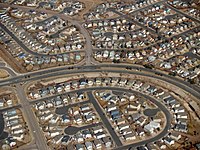
Photo from wikipedia
Abstract Building information modelling (BIM) and geographical information systems (GIS) provide digital representation of architectural and environmental entities. BIM focuses on micro-level representation of buildings themselves, and GIS provide macro-level… Click to show full abstract
Abstract Building information modelling (BIM) and geographical information systems (GIS) provide digital representation of architectural and environmental entities. BIM focuses on micro-level representation of buildings themselves, and GIS provide macro-level representation of the external environments of buildings. Moreover, their combination can establish a comprehensive view of a built environment based on data integrated, which underpins the development and transition of the architecture, engineering and construction (AEC) industries in the digital era. This paper gives a comprehensive review on BIM-GIS integration in sustainable built environments in order to analyse the status quo and practical applications from four viewpoints: technologies for data integration, applications in the life cycle of AEC projects, building energy management, and urban governance. Three typical modes of BIM-GIS integration, namely, “BIM leads and GIS supports”, “GIS leads and BIM supports”, and “BIM and GIS are equally involved”, are categorised based on the different dominant positions of the two technologies. Furthermore, the research trends and future directions for the applications of BIM-GIS integration are discussed. Specifically, we underline that semantic models and third-party integration platforms should be optimised technically, and information about the whole process of AEC projects needs to be improved. Comprehensive information for building energy management should be digitised and quantified to improve its systematic integration and application to the urban built environment. This review can serve as a roadmap for researchers who focus on studies of BIM-GIS integration in the sustainable built environment.
Journal Title: Automation in Construction
Year Published: 2019
Link to full text (if available)
Share on Social Media: Sign Up to like & get
recommendations!